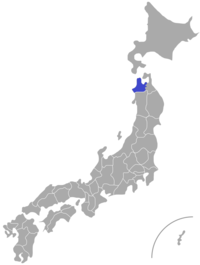|
Tsugaru dialect
The Tsugaru dialect (津軽弁, Tsugaru-ben) is a Japanese dialect spoken in western Aomori Prefecture. The Tsugaru dialect is reputed to be so divergent from standard Japanese for those who are not native speakers, that even people living in the same prefecture may have trouble understanding it.[1][note 1] In 1988, fans of the Tsugaru dialect proclaimed October 23 to be Tsugaru Dialect Day (津軽弁の日, Tsugaru-ben no hi). October 23 is the anniversary of the death of Takagi Kyozo, a famous poet who wrote in the Tsugaru dialect. In Tsuruta, there is an annual summer Tsugaru-ben competition (津軽弁大会, Tsugaru-ben taikai) in which teams of foreigners create short skits or performances, usually humorous, using the dialect. In June 2009, a short segment featuring the competition was broadcast nationally on NHK. ExamplesThe words are sometimes very different from those of standard Japanese.
Notes
References
External links
|
||||||||||||||||||||||||||||||||||||||||||||||||||||||||||||||||||||||||||||||||
